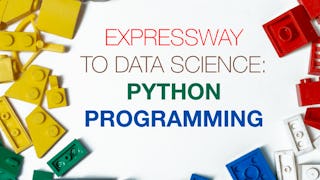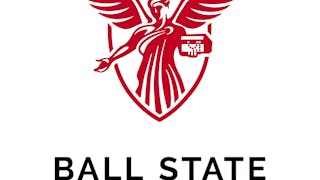Modern programs are complicated structures, with hundreds to thousands of lines of code, but how do you efficiently move from smaller programs to more robust, complicated programs? How do data scientists simulate the randomness of real world problems in their programs? What techniques and best practices can you leverage to design pieces of software that can efficiently handle large amounts of data? In this course from Duke University, Python users will learn about how to create larger, multi-functional programs that can handle more complex tasks.



Designing Larger Python Programs for Data Science
Dieser Kurs ist Teil von Spezialisierung Programming for Python Data Science: Principles to Practice



Dozenten: Genevieve M. Lipp
Bei  enthalten
enthalten
Empfohlene Erfahrung
Empfohlene Erfahrung
Was Sie lernen werden
How to plan program decomposition using top down design.
How to integrate discrete pieces of Python code into a larger, more functional, and complex program.
Kompetenzen, die Sie erwerben
- Kategorie: Debugging
- Kategorie: Data Manipulation
- Kategorie: Test Case
- Kategorie: Python Programming
- Kategorie: Integration Testing
- Kategorie: Simulations
- Kategorie: Software Development
- Kategorie: Program Development
- Kategorie: Computer Programming
- Kategorie: Pandas (Python Package)
- Kategorie: Computational Thinking
- Kategorie: Development Testing
- Kategorie: Data Science
- Kategorie: Software Engineering
- Kategorie: Data Cleansing
- Kategorie: Data Analysis
- Kategorie: Data Structures
- Kategorie: Unit Testing
- Kategorie: Statistical Methods
- Kategorie: Software Design
Wichtige Details

Zu Ihrem LinkedIn-Profil hinzufügen
1 Aufgabe
Erfahren Sie, wie Mitarbeiter führender Unternehmen gefragte Kompetenzen erwerben.

Erweitern Sie Ihre Fachkenntnisse
- Lernen Sie neue Konzepte von Branchenexperten
- Gewinnen Sie ein Grundverständnis bestimmter Themen oder Tools
- Erwerben Sie berufsrelevante Kompetenzen durch praktische Projekte
- Erwerben Sie ein Berufszertifikat zur Vorlage

In diesem Kurs gibt es 4 Module
This module, you’ll learn how to apply the concepts you’ve learned previously to analyze larger programs. Additionally, we’ll go through the process of program decomposition, to break up a complicated program into smaller steps that we can solve easier. After all of those pieces, we’ll put our pieces together in a programming assignment that combines a lot of the smaller programs we’ve created throughout the module.
Das ist alles enthalten
6 Videos3 Lektüren4 Programmieraufgaben
This Module, you’ll learn about Monte Carlo methods, which are a common technique we use to simulate a lot of possible outcomes. We’ll also introduce you to the Poker Project that you’ll be working on for the rest of the course. In this module we’ll focus on how we can write code to simulate different possible outcomes for a hand of poker, and the individual programming problems we’ll need to solve to make a complete poker simulation. You’ll create some of these smaller solutions in this module, and receive feedback on these individual pieces before we move onto synthesizing some of these parts together in the next module.
Das ist alles enthalten
1 Video2 Lektüren3 Programmieraufgaben
This module, you will learn about writing test cases and debugging in a Python program, and apply it to your poker project! Additionally we’ll move forward to the logical evaluation part of the poker project, where you’ll write the code that will allow your program to decide what a winning hand would be, and use some data science techniques to help clean up the data generated by Monte Carlo methods. Similarly to the last unit, you’ll write these individual parts of the program and get feedback on those, before we move on to the next unit, where we’ll synthesize all of these pieces into a complete poker hand simulation.
Das ist alles enthalten
1 Lektüre1 Aufgabe3 Programmieraufgaben
This module, we’ll integrate all of the individual sections of Python code that we’ve written throughout the course into one larger program. This will likely require a bit of troubleshooting and forethought to get all of your previous bits of code working, but you will leverage the test cases and skills you learned in the previous module to accomplish this. We’ll also go over object references, a way that we can directly reference a piece of memory, to efficiently update the information that the various parts of your program will be using. After all of this, we’ll give feedback on your final poker project, and then we’ll ask you to do a short reflection on your poker project and the experience you had creating a larger program from its discrete components.
Das ist alles enthalten
1 Video1 Lektüre2 Programmieraufgaben1 Diskussionsthema
Erwerben Sie ein Karrierezertifikat.
Fügen Sie dieses Zeugnis Ihrem LinkedIn-Profil, Lebenslauf oder CV hinzu. Teilen Sie sie in Social Media und in Ihrer Leistungsbeurteilung.
Dozenten

Mehr von Software Development entdecken
 Status: Kostenloser Testzeitraum
Status: Kostenloser Testzeitraum
Duke University
 Status: Kostenloser Testzeitraum
Status: Kostenloser Testzeitraum
University of Colorado Boulder
 Status: Preview
Status: Preview
Ball State University
 Status: Kostenloser Testzeitraum
Status: Kostenloser Testzeitraum
Fractal Analytics
Warum entscheiden sich Menschen für Coursera für ihre Karriere?





Neue Karrieremöglichkeiten mit Coursera Plus
Unbegrenzter Zugang zu 10,000+ Weltklasse-Kursen, praktischen Projekten und berufsqualifizierenden Zertifikatsprogrammen - alles in Ihrem Abonnement enthalten
Bringen Sie Ihre Karriere mit einem Online-Abschluss voran.
Erwerben Sie einen Abschluss von erstklassigen Universitäten – 100 % online
Schließen Sie sich mehr als 3.400 Unternehmen in aller Welt an, die sich für Coursera for Business entschieden haben.
Schulen Sie Ihre Mitarbeiter*innen, um sich in der digitalen Wirtschaft zu behaupten.
Häufig gestellte Fragen
Access to lectures and assignments depends on your type of enrollment. If you take a course in audit mode, you will be able to see most course materials for free. To access graded assignments and to earn a Certificate, you will need to purchase the Certificate experience, during or after your audit. If you don't see the audit option:
The course may not offer an audit option. You can try a Free Trial instead, or apply for Financial Aid.
The course may offer 'Full Course, No Certificate' instead. This option lets you see all course materials, submit required assessments, and get a final grade. This also means that you will not be able to purchase a Certificate experience.
When you enroll in the course, you get access to all of the courses in the Specialization, and you earn a certificate when you complete the work. Your electronic Certificate will be added to your Accomplishments page - from there, you can print your Certificate or add it to your LinkedIn profile. If you only want to read and view the course content, you can audit the course for free.
If you subscribed, you get a 7-day free trial during which you can cancel at no penalty. After that, we don’t give refunds, but you can cancel your subscription at any time. See our full refund policy.
Weitere Fragen
Finanzielle Unterstützung verfügbar,


